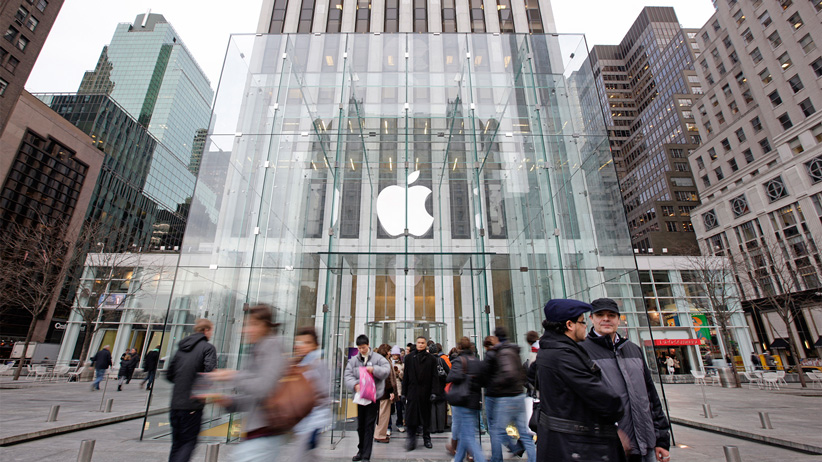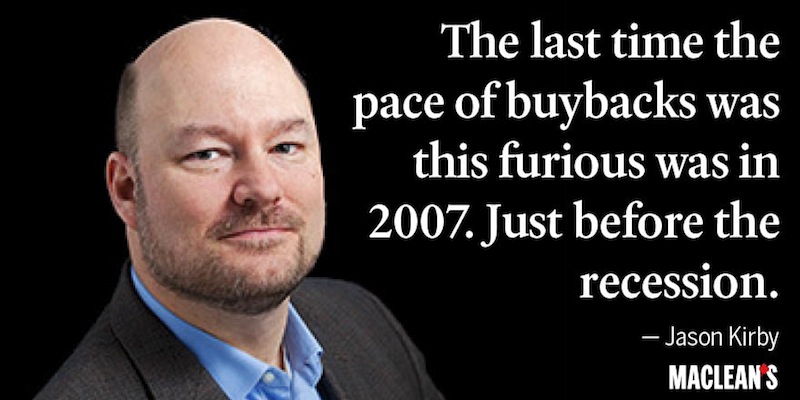Why it’s time to say bye-bye to buybacks
Buybacks, like the one Apple just announced, are why the stock market’s been soaring despite a recession. But they come with a cost, writes Jason Kirby.
USA, New York, New York City: – Apple Store at 5th Avenue (Oliver Killig/Getty Images)
Share

It’s hardly a secret that a lot of people aren’t tickled by the state of modern capitalism. But it says a lot that Larry Fink is one of them. For those who don’t recognize the name, Fink is the founder and CEO of BlackRock, the world’s largest money management firm. Not impressed yet? Let’s try that again. Fink runs a company that oversees US$4.7 trillion—yes, that’s a “t”—in assets for investors. So the other day when he fired off letters to the CEOs of every company on the S&P 500 stock index warning about a fundamental flaw in today’s markets, the financial world took notice.
Specifically, Fink is alarmed by the scale of money being spent by companies to juice their own share prices. A company with cash at its disposal effectively has three choices. It can hold on to the money, spend it to grow its business, or give it back to shareholders through dividends or by buying back its shares. With activist shareholders braying for quick returns on their investments, companies are overwhelmingly opting for the latter. But that comes at a cost. As Fink noted, companies are “under-investing in innovation, skilled workforces or essential capital expenditures necessary to sustain long-term growth . . . The effects of the short-termist phenomenon are troubling both to those seeking to save for long-term goals such as retirement and for our broader economy.”
It’s no surprise investors are giddy for buybacks, which tend to boost a company’s stock price by reducing the number of shares in the marketplace. In the same way, rising dividends attract investors hungry for yield in a world of near-zero per cent interest rates. None of this is new, or even necessarily bad. But it’s the sheer scale that’s troubling. Last year U.S. companies devoted about $915 billion, or 95 per cent of their profits, to share repurchases and dividends, according to an analysis by Bloomberg. This year it’s expected that figure will blow past the $1-trillion mark. If you’ve been wondering why the stock market has been on a tear in recent years even though the economy has been in the dumps, well, there’s your answer.
The latest blockbuster buyback announcement came this week when Apple reported its second-quarter earnings. Last year Apple spent $56 billion on share buybacks. Now it plans to boost its “capital return program” to $200 billion over the next two years, with $140 billion of that amount earmarked for share repurchases. (The balance will be handed out to investors in higher dividends.) In announcing the buyback plan, Apple CEO Tim Cook stressed all the worthy things the company was doing with its existing cash hoard before declaring Apple simply has more money than it possibly needs to run its business.

Apple is arguably a special case in corporate America. It’s a money-creating machine, with roughly $194 billion in cash, short- and long-term marketable securities on its balance sheet and anywhere from $10 billion to $20 billion in profit rolling in each quarter. Apple can give mountains of money back to shareholders and continue to innovate. But it’s also true that Apple’s buyback program was a direct response to pressure from its largest shareholder, corporate raider Carl Icahn. If Cook had his way, he might prefer to hold on to Apple’s war chest, knowing that dominance in technology is fleeting.
The explosion in buybacks is far more troubling when it comes to companies like General Motors, which announced a $5-billion stock buyback in March to avoid a battle with an activist hedge fund, and General Electric, which last month said it would return $50 billion to investors even as it restructures its business to become a pure industrial manufacturer. At both, as with so many of the companies announcing buyback plans, there are more pressing concerns, like how to steel their businesses against changing markets and fierce competition. Instead, by opting to goose their short-term stock price, companies risk robbing themselves of funds for that future investment.
For CEOs, buybacks are inherently a risk-averse response, far easier than facing investors with a growth plan that entails a potentially lucrative but uncertain reward down the road. But the tactic fails to take into account that buybacks themselves are risky. The last time the pace of buybacks was this furious was in 2007, just before the recession. Then, as now, companies paid top dollar for their own shares, falling into the investor trap of buying high. It also left many companies ill-prepared to take advantage of the crisis when it hit.
Will executives heed Fink’s warning? Don’t bet on it. In this short-term world, most CEOs who got his letter won’t be around long enough to worry about the future.